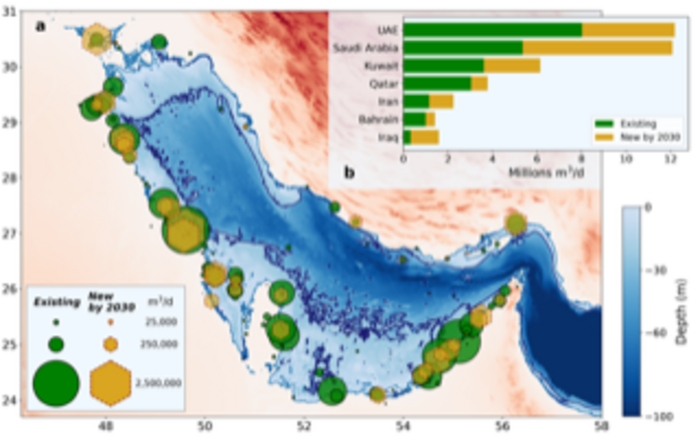A research group from (New York University) NYU Abu Dhabi’s Arabian Center for Climate and Environmental ScienceS (ACCESS) and Water Research Center have gained insights into how high use of desalination technologies jointly with projected climate change will cause an impact on the Gulf-wide salinity in the years to come.
 This map shows the current and projected areas of increased brine as a result of desalination efforts in the Arabian Gulf region. Image Credit: Courtesy of NYUAD.
This map shows the current and projected areas of increased brine as a result of desalination efforts in the Arabian Gulf region. Image Credit: Courtesy of NYUAD.
The nations neighboring the Arabian Gulf are known to be the world’s biggest users of desalination technologies to fulfill their freshwater needs. High desalination will result in elevated amounts of hypersaline (high-salt) brine that are being discharged into the Gulf. It has been unclear what impact this will have on the marine ecosystems and fisheries of the Gulf.
In the study reported in the journal Scientific Reports, the scientists discovered that, even under the most significant climate change and projected desalination scenario, salinity raises would be well within the range of natural salinity variation as a result of evaporation.
Hence, such minor salinity variations are not anticipated to have environmental impacts at the Gulf scale, as marine life has suited to the high and variable natural salinity.
The main discovery was that any increase in salinity would force an equivalent increase into the flux via the Hormuz strait. This leads to a highly quick renewal of the Gulf waters. As a result, also in extreme-case scenarios, the increases in basin-scale salinity are not projected to surpass a level that will consist of a considerable effect on the marine life of the Gulf. This includes flora and fauna, as such levels of salinity increase are well inside the natural range of variability that organisms in the Gulf are exposed to in an earlier manner.
The happening of hypoxia, low, or depleted oxygen levels in a body of water, appears to pose a bigger threat to marine life in both the innermost part of the Gulf, as well as in the shallow reefs, as documented in earlier studies from these authors and others at NYUAD. Also, it is a condition that is not linked to desalination brine discharge.
While other modeling studies have attempted to evaluate the increase of salinity at basin-wide scales as a result of desalination, this is the first model of its kind to also take into account the possible forthcoming effects of climate change.
Since the Gulf region is the residence of the biggest desalination plant complexes in the world and 45% of worldwide freshwater desalination production, it is necessary to take the long-term impacts of this industry into account.
The data collected concerning the expected levels of salinity in the Gulf coastal waters could guide the future study of the other effects of extensive desalination. This includes the economic impacts of variations on the fishing industry.
Our team’s research provides valuable, new insights into the impacts of this critical industry for the Gulf region. We have developed a reliable model that has allowed us to predict changes in salinity over the next few decades, advancing the ability of our team and the greater scientific community to determine ways to protect our ecosystems better.
Francesco Paparella, Principal Investigator, Arabian Center for Climate and Environmental Sciences, New York University Abu Dhabi
“The Gulf is a naturally extreme marine system, and we have been utilizing a growing fraction of its waters for desalination purposes. This raises concerns about whether this may have ecological consequences, particularly in this era of a rapidly changing climate,” stated John Burt, Co-Principal Investigator at the NYUAD Water Research Center and the Arabian Center for Climate and Environmental Sciences.
Dr. Burt added, “the results of this work show that salinity increases under even the worst-case climate projections and increased desalination in coming decades are likely to have only negligible impacts on salinity at the Gulf-wide scale, and well within the normal seasonal variation in salinity that organisms here are already exposed to.”
Dr. Burt continued, “While we need further research on processes occurring at more localized scales around desalination plants, these results suggest that there is little cause for concern of salinity increases at the Gulf-wide scale.”
Journal Reference:
Paparella, F., et al. (2022) Long-term, basin-scale salinity impacts from desalination in the Arabian/Persian Gulf. Scientific Reports. doi.org/10.1038/s41598-022-25167-5.